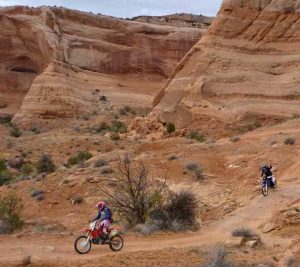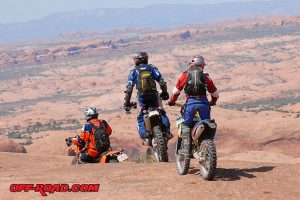 A nine-year court battle over motorized recreation in Utah’s red rock country has ended with a compromise agreement in which the BLM will take a new look at 13 travel management plans covering about 6 million acres. A consortium of environmental organizations had challenged 2008 travel plans from six BLM field offices that included 20,000 miles of trails. The settlement drops the challenges in one field office and about half the targeted acreage, while mandating site-specific reassessment in such popular areas as the San Rafael Swell, Nine Mile Canyon, Dolores River, Gemini Bridges, and the Book Cliffs, as well as Arches and Canyonlands national parks, Glen Canyon National Recreation Area and Dinosaur National Monument. The settlement allows oil and gas leases sold in 2004 to proceed, mostly in the Uinta Basin.
A nine-year court battle over motorized recreation in Utah’s red rock country has ended with a compromise agreement in which the BLM will take a new look at 13 travel management plans covering about 6 million acres. A consortium of environmental organizations had challenged 2008 travel plans from six BLM field offices that included 20,000 miles of trails. The settlement drops the challenges in one field office and about half the targeted acreage, while mandating site-specific reassessment in such popular areas as the San Rafael Swell, Nine Mile Canyon, Dolores River, Gemini Bridges, and the Book Cliffs, as well as Arches and Canyonlands national parks, Glen Canyon National Recreation Area and Dinosaur National Monument. The settlement allows oil and gas leases sold in 2004 to proceed, mostly in the Uinta Basin.
Stephen Bloch, legal director for the Southern Utah Wilderness Alliance, commented that “the negotiations leading up to the settlement agreement were hard fought, and contentious. In the end, we came to a place that provided sufficient certainty to the conservation groups that BLM would take seriously its responsibilities to minimize the impacts of off-road vehicle use on all public resources, including wilderness.”
 On the other side of the table, Paul Turcke, the attorney for off-highway vehicle groups, said, “We’re not turning cartwheels over this, but given the alternatives and given the fact that we could participate effectively and make positive changes to this agreement, we think it’s the best option for moving forward.” Motorized recreation enthusiasts applauded the lack of any immediate changes on the ground; no routes were closed as part of the settlement, though some are likely to be shut down during the renewed planning process. Turke notes, “Everyone gets a fair shake in the future process and they can challenge the outcome if they choose.”
On the other side of the table, Paul Turcke, the attorney for off-highway vehicle groups, said, “We’re not turning cartwheels over this, but given the alternatives and given the fact that we could participate effectively and make positive changes to this agreement, we think it’s the best option for moving forward.” Motorized recreation enthusiasts applauded the lack of any immediate changes on the ground; no routes were closed as part of the settlement, though some are likely to be shut down during the renewed planning process. Turke notes, “Everyone gets a fair shake in the future process and they can challenge the outcome if they choose.”
The State of Utah and several counties were strongly opposed to the settlement, largely on the basis of longstanding local claims to old roads in the desert. 3000 miles of these so-called RS2477 roads are laced across the BLM land subject to the settlement. “The settlement creates a new regime that is designed to limit access and close travel routes,” the Utah attorney general’s office wrote in a brief filed in February, asking U.S. District Judge Dale Kimball to reject the settlement; “Requiring the BLM to enhance wilderness characteristics, for example, can only be accomplished by closing roads.”
Not incidentally, SUWA’s legal challenge contended that the BLM relied too heavily on the old county roads when it made its 2008 decisions about where to authorize travel, claiming that some of these routes are no longer visible on the ground. The legal challenge targeted the need for more assessment and protection of archeological resources, along with calls for more wilderness protection and designation of three areas of critical environmental concern. Any reductions in motorized use will enhance opportunities for quiet recreation and increase the area within which hikers can experience the deep solitude of the desert and its canyons. The ideal solution will be creating more separation between motorized and quiet recreation sites.
As Earthjustice attorney Robin Cooley said after the settlement was announced, “BLM must take a fresh look at where it will allow off-highway vehicles to drive, this time with an eye towards protecting the very things that make Utah’s redrock country so special — its wildness, opportunities for solitude, and irreplaceable archaeological sites.”
Interestingly, the indispensable High Country News ran a piece recently entitled “The making of a motorhead,” which puts a human face on the debate. At the time I’m posting, the article is in the subscribers-only portion of their site, but if it opens up to others, it’s well worth a read. This excerpt captures some of the tone:
Like me, my companions in this adventure were lovers of wilderness, and many of the remote places we intended to explore were essentialy roadless. Our plan was to ride until we couldn’t, and then hike, scramble and climb to our destination, traveling on foot as light and fast as we could on our stripped-down motorbikes. Save for the obvious carbon footprint and the knobby tracks in the soft sand, our multi-day, two-wheel adventure ride would adhere to the Leave-No-Trace ethos championed by backcountry bipeds. We would be heard, seen, and then gone.
